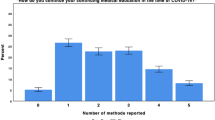Abstract
The use of Web 2.0 tools in education and health care has received heavy attention over the past years. Over two consecutive years, Children's Cancer Hospital - Egypt 57357 (CCHE 57357), in collaboration with Egyptian universities, student bodies, and NGOs, conducted a summer course that supports undergraduate medical students to cross the gap between clinical practice and clinical research. This time, there was a greater emphasis on reaching out to the students using social media and other Web 2.0 tools, which were heavily used in the course, including Google Drive, Facebook, Twitter, YouTube, Mendeley, Google Hangout, Live Streaming, Research Electronic Data Capture (REDCap), and Dropbox. We wanted to investigate the usefulness of integrating Web 2.0 technologies into formal educational courses and modules. The evaluation survey was filled in by 156 respondents, 134 of whom were course candidates (response rate = 94.4 %) and 22 of whom were course coordinators (response rate = 81.5 %). The course participants came from 14 different universities throughout Egypt. Students' feedback was positive and supported the integration of Web 2.0 tools in academic courses and modules. Google Drive, Facebook, and Dropbox were found to be most useful.

Similar content being viewed by others
References
Chu LF, Young C, Zamora A et al (2010) Anesthesia 2.0: internet-based information resources and Web 2.0 applications in anesthesia education. Curr Opin Anaesthesiol 23:218–227. doi:10.1097/ACO.0b013e328337339c
Wang AT, Sandhu NP, Wittich CM et al (2012) Using social media to improve continuing medical education: a survey of course participants. Mayo Clin Proc 87:1162–1170. doi:10.1016/j.mayocp.2012.07.024
Forgie SE, Duff JP, Ross S (2013) Twelve tips for using Twitter as a learning tool in medical education. Med Teach 35:8–14. doi:10.3109/0142159X.2012.746448
Schmitt TL, Sims-Giddens SS, Booth RG (2012) Social media use in nursing education. Online J Issues Nurs 17:2
Billings DM (2012) Meaningful use of Web 2.0 tools for teaching and learning. J Contin Educ Nurs 43:152–153. doi:10.3928/00220124-20120327-11
Anderson P (2007) What is Web 2.0? Ideas, technologies and implications for education. JISC, Bristol, UK
Kamel Boulos MN, Wheeler S (2007) The emerging Web 2.0 social software: an enabling suite of sociable technologies in health and health care education. Health Info Libr J 24:2–23. doi:10.1111/j.1471-1842.2007.00701.x
Harris PA, Taylor R, Thielke R et al (2009) Research electronic data capture (REDCap)—a metadata-driven methodology and workflow process for providing translational research informatics support. J Biomed Inform 42:377–381. doi:10.1016/j.jbi.2008.08.010
Google Google Drive. http://drive.google.com. Accessed 27 Nov 2013
Mendeley 2013 Mendeley. http://www.mendeley.com/. Accessed 27 Nov 2013
Marzouki Y, Béjaoui M, Hammoudi H, Bellaj T (2012) The contribution of Facebook to the 2011 Tunisian revolution: a cyberpsychological insight. Cyberpsychol Behav Soc Netw 15:237–244. doi:10.1089/cyber.2011.0177
Massachusetts Institute of Technology 2013 MIT OpenCourseWare. http://ocw.mit.edu. Accessed 27 Nov 2013
University of California Berkeley 2013 University of California Berkeley Webcast. http://webcast.berkeley.edu. Accessed 27 Nov 2013
Utah State University 2013 Utah State OpenCourseWare. http://ocw.usu.edu/. Accessed 27 Nov 2013
Coursera 2013 Coursera. www.coursera.org. Accessed 27 Nov 2013
Udacity 2013 Udacity. www.udacity.com. Accessed 27 Nov 2013
EdX 2013 EdX. www.edx.org. Accessed 27 Nov 2013
Carnegie Mellon University 2013 Open learning initiative. http://oli.cmu.edu. Accessed 27 Nov 2013
Liyanagunawardena TR, Adams AA, Williams SA (2013) MOOCs: a systematic study of the published literature 2008–2012. Int Rev Res Open Distance Learn 14:202–227
Paton C, Bamidis PD, Eysenbach G et al (2011) Experience in the use of social media in medical and health education. Contribution of the IMIA Social Media Working Group. Yearb Med Inform 6:21–29
GoPath Diagnostics 2013 Global pathology course. http://www.gopathdx.com/m.php?name=lectures&mo_catid=49. Accessed 27 Nov 2013
Acknowledgments
We would like to acknowledge with gratitude the course tutors, CCHE research department team, MRS and AMSRA student societies, ABCDE society members, and all those who put effort into this educational initiative. In particular, we would like to acknowledge the following course coordinators: Maram Nassef, Ahmed Magdy, Mohamed Ghallab, Ibrahim Sehsah, Islam Khaled, Mohamed Adel, Radwa Jamal, Amr El-Foly, Hossam Asfour, Maha ElHawary, Hossam AbdelRazik, Omar Afifi, Nouran AbdelMoaemen, Hend Ayman, Noha Nasr El-Din, Hadeel Mohamed, Ahmed Mousa, Hossam ElEgeizy, Mohamed Shaaban, Omar Eltawansy, Yara Mohamed, Youssef Ahmed, Mohamed Sayed, Hadeel AbdulWahed, Mohamed Gomaa, Sara Ali, and Mohamed AbdelWaheb. We would like to thank Stefanie Baertele for revising the manuscript and Patricia Pruden for her support during the planning and implementation of the course over two consecutive years.
Conflicts of Interest
We hereby declare that the course was completely free to participate in and was organized for noncommercial purposes. The authors were involved in both the organization and the assessment of the course reported in this study. The corresponding author is the owner of an e-learning company that did not contribute to this work.
Author information
Authors and Affiliations
Corresponding author
Rights and permissions
About this article
Cite this article
Amgad, M., AlFaar, A.S. Integrating Web 2.0 in Clinical Research Education in a Developing Country. J Canc Educ 29, 536–540 (2014). https://doi.org/10.1007/s13187-013-0595-5
Published:
Issue Date:
DOI: https://doi.org/10.1007/s13187-013-0595-5




